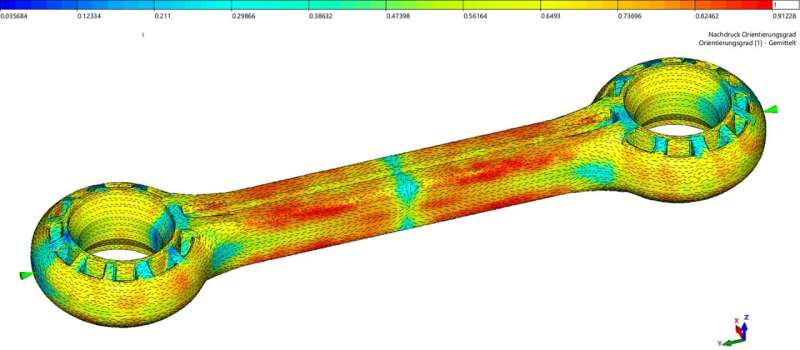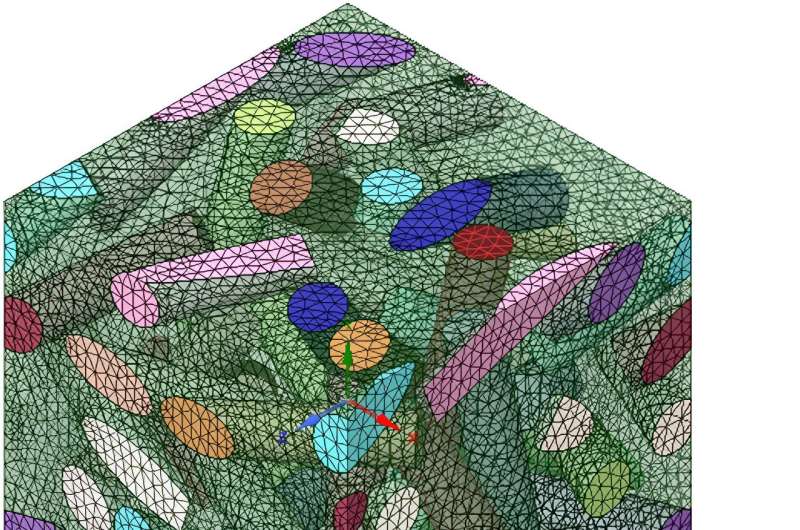This article has been reviewed according to Science X's editorial process and policies. Editors have highlighted the following attributes while ensuring the content's credibility:
fact-checked
trusted source
proofread
Durable, low-emission vehicle components made from fiber-reinforced biopolymers

Plastics have many positive properties: They are lightweight, durable and provide a wide range of design possibilities. However, conventional lightweight components made of fossil-based plastics offer great scope for reducing CO2 emissions.
As part of the COOPERATE project, researchers from the Fraunhofer Institute for Structural Durability and System Reliability LBF are working with industry and research partners to replace fossil-based plastics with bio-based alternatives. They are also developing methods that favor a more economical use of materials in order to improve the product design in terms of life cycle assessment and sustainability. The aim is to reduce the CO2 content of vehicle components and industrial applications by up to 50%.
Industry wants and needs to halve its emissions by 2030 in line with the German federal government's requirements. Lightweight design can make a significant contribution in this respect, enabling many tons of CO2 to be saved per year.
As part of the COOPERATE project (short for CO2-neutral, lifetime-optimized, short-fiber-reinforced thermoplastics for dynamic applications), the partners are working on reducing CO2 emissions in the design of lightweight vehicle components that must be able to withstand high mechanical and dynamic loads. These include, for example, load-bearing plastic components, such as engine mounts or coupling rods, as part of the chassis. In order to reduce the need for CO2 in the production of plastic components, the project partners are combining two approaches.
First, they are substituting fossil-based plastics for bio-based ones (i.e., fiber-reinforced biopolymers). The latter are made from renewable raw materials, such as agricultural by-products. One aspect of the project involves optimizing a biopolyamide derived from linseed oil to be used in durable, lightweight components that are subject to vibrations.
Second, the researchers are reducing environment-damaging greenhouse gas emissions by developing a material-specific design and reducing the amount of material used. The partners are therefore developing improved methods for designing components favoring a more economical use of materials. The stress resistance of the material is one factor that must be considered in this process. The target is to reduce the amount of material used by 20 to 30%. This in turn will lead to a reduction in the energy required to heat and melt the materials in the manufacturing process.
"Environmentally friendly substitutes can reduce CO2 emissions by more than 50% throughout the entire life cycle. We are focusing on the matrix material in the composite and are halving the emissions there in comparison to conventional plastics, achieving 4.5 kg of CO2 per kg of product weight versus 9 kg of CO2 per kg of product weight," says Georg Stoll, project manager and researcher at Fraunhofer LBF in Darmstadt. "The subsequent decrease in vehicle weight also means that less drive power is required, which in turn reduces the carbon footprint."
Fraunhofer LBF is working on optimizing the design process and substituting fossil-based materials together with BOGE Elastmetall GmbH (a manufacturer of vibration control systems and plastic components for the automotive industry), TECNARO GmbH (a company that develops biopolymers and biocomposites from renewable raw materials) and the Chair of Carbon Composites (LCC) at the Technical University of Munich.

Better life cycle assessment and greater sustainability in product development
New calculation methods that take into account the influences of manufacturing on the quasi-static and cyclical behavior of the materials are also being developed as part of the project. Using these enhanced simulation methods, it is possible to estimate material properties, such as rigidity and strength, based on the arrangement of the fibers in the component, for example.
"We are simulating both the manufacturing process and component behavior. This enables us to determine—right from the virtual design and development process—how to design the component so that less material is used," explain the researchers. Fraunhofer LBF and the LCC at the Technical University of Munich are developing the required models for characterizing material behavior in the finished component, which are based on experimental data collected by Fraunhofer LBF and data provided by BOGE Elastmetall GmbH.
Specimen geometries made of the biopolymer are currently being manufactured using the injection molding process and characterized on test benches at Fraunhofer LBF. The tests are providing important insights into the influence of temperature, humidity and notch radii in the component geometry on the rigidity and structural durability of the material.
The acoustic and vibration characteristics are also taken into account in order to be able to effectively reduce or completely suppress unwanted vibrations and disruptive noise. After all, future plastic fittings or door panels should not rattle, and any engine noise should ideally be imperceptible to vehicle occupants. Tests are being carried out on a prototype coupling rod. The aim is to optimize its shape over the course of the project in order to reduce material usage.
"The performance capabilities of biopolymers are continuously improving, and nowadays bio-based plastics have almost the same properties as their fossil-based counterparts, which have undergone decades of optimization. Nevertheless, designing a sustainable component that can support the same loads as a component made of greenhouse gas-intensive materials—while weighing less—is still a great challenge," explains Stoll.
The project partners want to use the new, resource-efficient methods and improved material properties for lightweight design to pave the way for the use of biopolymers in other technology sectors and application fields, such as mechanical engineering.




















